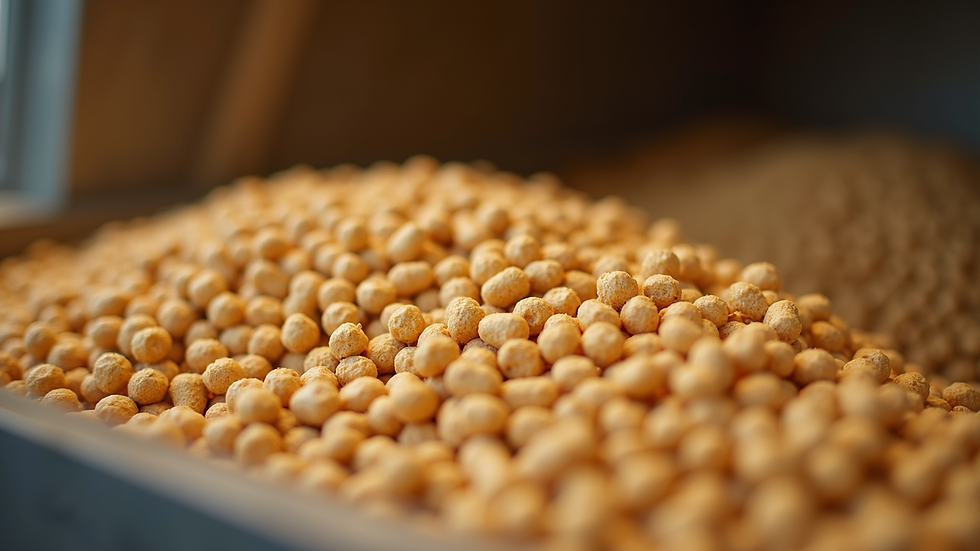Key Animal Feed Ingredients for Nutrition
- global6312
- Nov 3
- 4 min read
In the agricultural sector, the quality of feed directly influences the health and productivity of livestock. Understanding the essential feed components is crucial for businesses involved in pet food, animal feed, organic fertilizers, feed mills, fish farming, and poultry farming. Selecting the right ingredients ensures balanced nutrition, promotes growth, and supports sustainable farming practices. In this article, I will explore the key animal feed ingredients that form the foundation of effective nutrition strategies.
Understanding Essential Feed Components
Animal nutrition depends on a combination of various feed components that provide energy, protein, vitamins, minerals, and fiber. Each component plays a specific role in maintaining animal health and optimizing production. The essential feed components include:
Carbohydrates: The primary energy source for animals, carbohydrates are found in grains such as corn, barley, and wheat. They fuel daily activities and metabolic processes.
Proteins: Proteins supply amino acids necessary for growth, tissue repair, and immune function. Common protein sources include soybean meal, fish meal, and alfalfa.
Fats: Fats provide concentrated energy and support the absorption of fat-soluble vitamins. Sources include vegetable oils and animal fats.
Vitamins and Minerals: These micronutrients regulate vital biochemical reactions and maintain bone health, reproduction, and overall well-being.
Fiber: Fiber aids digestion and maintains gut health, especially in ruminants. It is typically sourced from hay, straw, and other roughages.
Balancing these components according to the species, age, and production goals is essential. For example, poultry requires higher protein levels compared to ruminants, while fish farming demands specific amino acid profiles.

Carbohydrates and Energy Sources in Feed
Carbohydrates are the backbone of animal feed, providing the energy necessary for maintenance, growth, and reproduction. They are mainly present as starches and sugars in cereal grains. Corn is the most widely used carbohydrate source due to its high energy content and digestibility. Barley and wheat also contribute valuable carbohydrates but differ in fiber content and digestibility.
In fish farming, carbohydrate sources must be carefully selected to avoid digestive issues. Ingredients like wheat gluten and rice bran are often preferred for their digestibility and nutrient profile.
It is important to consider the processing methods of carbohydrate sources. Grinding, pelleting, or extrusion can improve digestibility and feed efficiency. However, over-processing may reduce nutrient availability.
Protein Sources and Their Importance
Proteins are indispensable for animal growth and productivity. They provide essential amino acids that animals cannot synthesize on their own. Selecting high-quality protein sources is critical to meet nutritional requirements without excess nitrogen excretion, which can harm the environment.
Soybean meal is a common plant-based protein source, valued for its balanced amino acid profile and availability. Fish meal, rich in essential amino acids and omega-3 fatty acids, is widely used in aquaculture and poultry feeds. Other protein sources include canola meal, sunflower meal, and insect-based meals, which are gaining attention for sustainability.
Incorporating diverse protein sources can improve feed palatability and nutrient balance. It also reduces dependency on a single ingredient, mitigating supply risks.

Vitamins, Minerals, and Additives
Vitamins and minerals are vital for metabolic functions, immune response, and skeletal development. Deficiencies can lead to poor growth, reproductive failures, and increased susceptibility to diseases.
Commonly supplemented vitamins include A, D, E, and B-complex, while minerals such as calcium, phosphorus, magnesium, and trace elements like zinc and selenium are essential. The bioavailability of these nutrients depends on their chemical form and interaction with other feed components.
Additives such as enzymes, probiotics, and antioxidants are increasingly incorporated to enhance nutrient absorption, improve gut health, and extend feed shelf life. For example, phytase enzymes help break down phytate-bound phosphorus, making it more accessible to animals and reducing environmental phosphorus pollution.
Fiber and Its Role in Digestion
Fiber is a critical component, especially for ruminants like cattle and sheep. It stimulates rumen function, promotes healthy microbial populations, and prevents digestive disorders. Sources of fiber include hay, straw, beet pulp, and other roughages.
In monogastric animals such as pigs and poultry, fiber is less critical but still important for gut motility and health. Excessive fiber can reduce nutrient digestibility, so its inclusion must be carefully managed.
Balancing fiber content ensures optimal feed intake and nutrient utilization. It also supports sustainable farming by utilizing agricultural by-products as feed ingredients.
Practical Recommendations for Feed Formulation
When formulating animal feed, consider the following practical steps:
Assess Nutritional Requirements: Determine the species, age, production stage, and health status to define nutrient needs.
Select Quality Ingredients: Use reliable sources of carbohydrates, proteins, fats, vitamins, and minerals.
Balance Rations: Ensure the feed meets energy, protein, and micronutrient requirements without excesses or deficiencies.
Incorporate Additives Wisely: Use enzymes, probiotics, and antioxidants to improve feed efficiency and animal health.
Monitor and Adjust: Regularly evaluate animal performance and adjust feed formulations accordingly.
For businesses seeking reliable and sustainable sources, exploring animal feed ingredients from trusted suppliers can streamline operations and enhance product quality.
Advancing Sustainable Animal Nutrition
Sustainability is a growing priority in animal nutrition. Using by-products, alternative protein sources, and organic fertilizers contributes to environmental stewardship. Green Terra Nutritions exemplifies this approach by providing sustainable animal protein feed and organic fertilizers with dependable logistics.
Adopting sustainable feed ingredients reduces reliance on finite resources and minimizes environmental impact. It also aligns with consumer demand for responsibly produced animal products.
Investing in research and innovation to improve feed efficiency and nutrient utilization will further support sustainable growth in the agricultural sector.
Final Thoughts on Essential Feed Components
Understanding and applying the principles of essential feed components is fundamental for optimizing animal nutrition. By carefully selecting and balancing carbohydrates, proteins, fats, vitamins, minerals, and fiber, businesses can enhance animal health, productivity, and sustainability.
The integration of high-quality animal feed ingredients into feed formulations supports these goals. It also strengthens supply chains and fosters long-term success in the competitive agricultural market.
Continued attention to feed quality and innovation will ensure that animal nutrition meets the evolving demands of the industry and contributes positively to global food security.



Comments